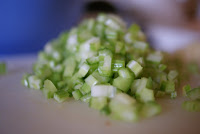 |
| Three Beans for Three Bean Salad |
 |
| Garlic and Shallots |
 |
| Celery |
 |
| Lemon Juice |
 |
| Basil and Parsley |
 |
| Lemon Zest |
My 3 cans of three different beans (chickpea, kidney, cannellini) - instead of the 3 cans of cannellinis recommended
1 large garlic clove, minced
3 tablespoons finely chopped shallots
1 large rib celery, finely diced
1/4 cup extra virgin olive oil - the original recipe recommends a 1/2 cup which just seemed like it would make everything kind of soupy
1/4 cup freshly squeezed lemon juice
Zest of one lemon
1 teaspoon kosher salt
1/2 teaspoon freshly ground black pepper
3/4 teaspoon sugar
1/2 teaspoon Worcestershire sauce
1/2 cup half chopped Italian parsley and half chopped basil - used instead of mint... because lovely as it sounds, I ain't got no mint
 |
| Ta-Da! Three Bean Salad |










































